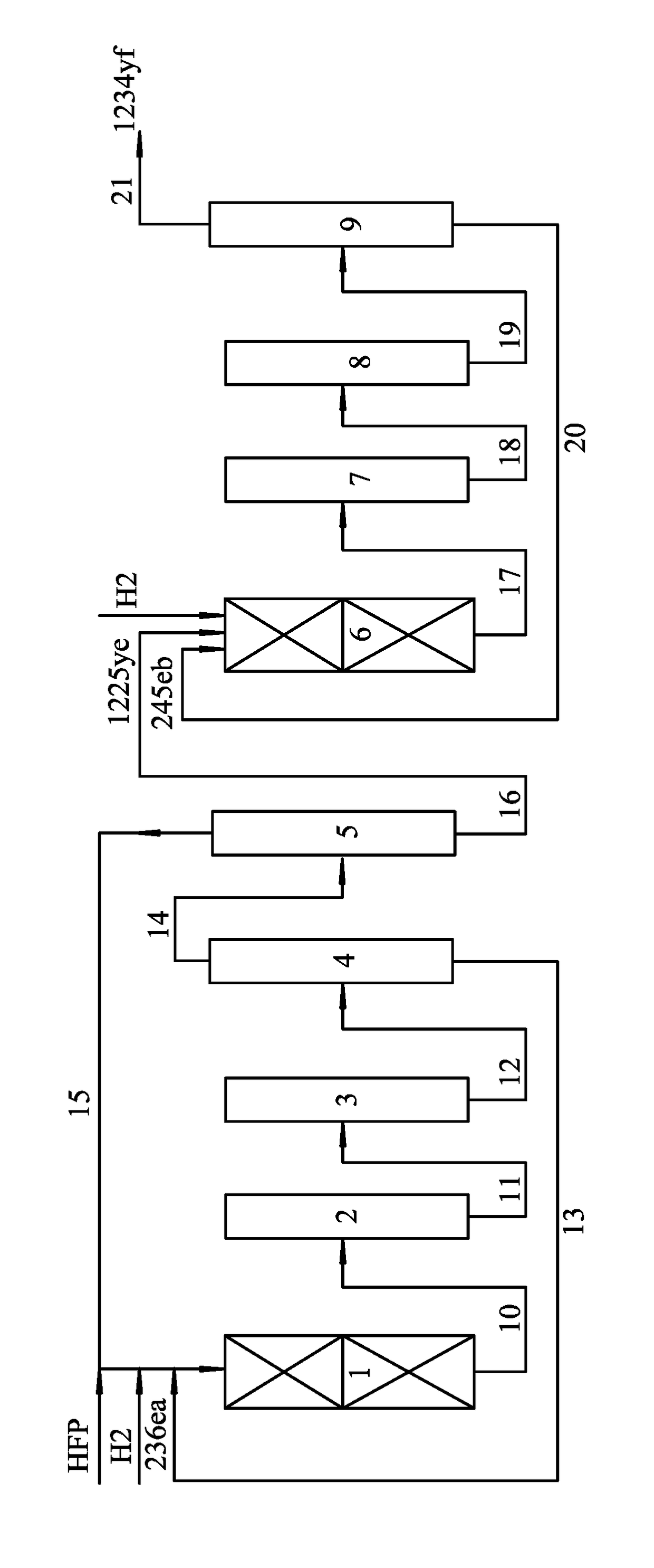Method for preparing 2,3,3,3-tetrafluoropropene
a technology of tetrafluoropropene and tetrafluoropropene, which is applied in the field of preparing 2, 3, 3, 3tetrafluoropropene, can solve the problems of long conventional method, inefficient and costly, and achieve the effects of less expensive, shortening conventional method, and reducing cos
- Summary
- Abstract
- Description
- Claims
- Application Information
AI Technical Summary
Benefits of technology
Problems solved by technology
Method used
Image
Examples
example 1
[0032]200 mL of a Cr2O3 catalyst was added with HF for fluorination at a temperature of 350° C. for 30 hrs to yield an activated Cr2O3 catalyst, which was then added to a lower section of the first reactor (adiabatic reactor made of carbon steel). 150 mL of a Pd / C catalyst (Pd accounts for 0.1 wt. %) was pretreated with a mixed gas comprising H2 and N2 (a molar ratio of H2 to N2 is 1:19) at a space velocity of 1200 mL g−1 (catal.) h−1 at a temperature of 350° C. for 15 hrs, then the Pd / C catalyst after treatment was filled in an upper section of the first reactor. The upper section of the first reactor was heated to a temperature of 50° C., and the lower section thereof was heated to the temperature of 300° C. Thereafter, hexafluoropropylene and H2 with a molar ratio of 1:0.95 was introduced to the first reactor at a space velocity of 300 h−1 for reaction, and products obtained from an outlet of the first reactor were washed by an alkaline and then samples were collected for analysi...
example 2
[0036]The activation of the Cr2O3 catalyst and the pretreatment of the Pd / C catalyst were the same as Example 1. 200 mL of the activated Cr2O3 catalyst was filled in a lower section of a first reactor (adiabatic reactor made of carbon steel), and 150 mL of the pretreated Pd / C catalyst (Pd accounts for 0.3 wt. %) was filled in an upper section of the first reactor. The upper section of the first reactor was heated to the temperature of 80° C., and the lower section of the first reactor was heated to the temperature of 280° C. Hexafluoropropylene and H2 were introduced to the first reactor at a molar ratio of hexafluoropropylene to H2 of 1:0.95 at a space velocity of 200 h−1 for reaction, and products obtained from an outlet of the first reactor were washed by an alkaline and then samples were collected for analysis, results of which are listed in Table 2-1.
[0037]
TABLE 2-1Data analysis of organic substances at an outlet of a first reactor1,1,1,2,3-1,1,1,2,3,3-Componentspentafluoroprop...
example 3
[0040]The activation of the Cr2O3 catalyst and the pretreatment of the Pd / C catalyst were the same as Example 1. 200 mL of the activated Cr2O3 catalyst was filled in a lower section of a first reactor (adiabatic reactor made of carbon steel), and 150 mL of the pretreated Pd / C catalyst (containing 0.5 wt. % of Pd) was filled in an upper section of the first reactor. The upper section of the first reactor was heated to the temperature of 100° C., and the lower section of the first reactor was heated to the temperature of 320° C. Hexafluoropropylene and H2 were introduced to the first reactor at a molar ratio of hexafluoropropylene to H2 of 1:0.97 at a space velocity of 800 h−1 for reaction, and products obtained from an outlet of the first reactor were washed by an alkaline and then samples were collected for analysis, results of which are listed in Table 3-1.
[0041]
TABLE 3-1Data analysis of organic substances at an outlet of a first reactor1,1,1,2,3-1,1,1,2,3,3-Componentspentafluoropr...
PUM
| Property | Measurement | Unit |
|---|---|---|
| temperature | aaaaa | aaaaa |
| temperature | aaaaa | aaaaa |
| temperature | aaaaa | aaaaa |
Abstract
Description
Claims
Application Information
 Login to View More
Login to View More - R&D
- Intellectual Property
- Life Sciences
- Materials
- Tech Scout
- Unparalleled Data Quality
- Higher Quality Content
- 60% Fewer Hallucinations
Browse by: Latest US Patents, China's latest patents, Technical Efficacy Thesaurus, Application Domain, Technology Topic, Popular Technical Reports.
© 2025 PatSnap. All rights reserved.Legal|Privacy policy|Modern Slavery Act Transparency Statement|Sitemap|About US| Contact US: help@patsnap.com

